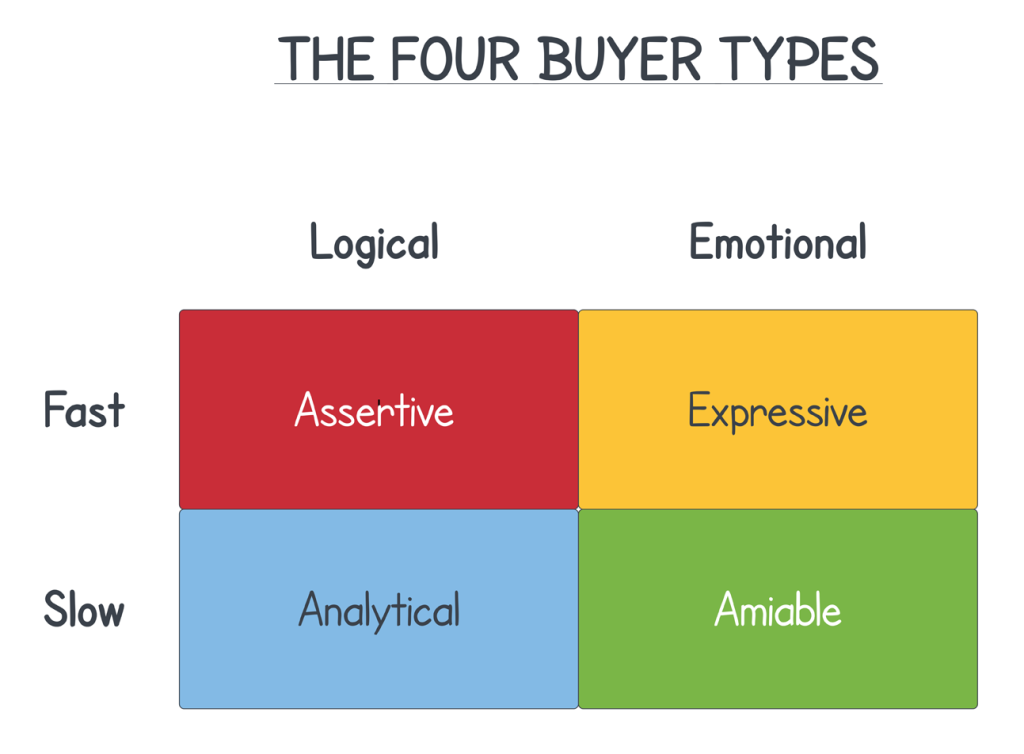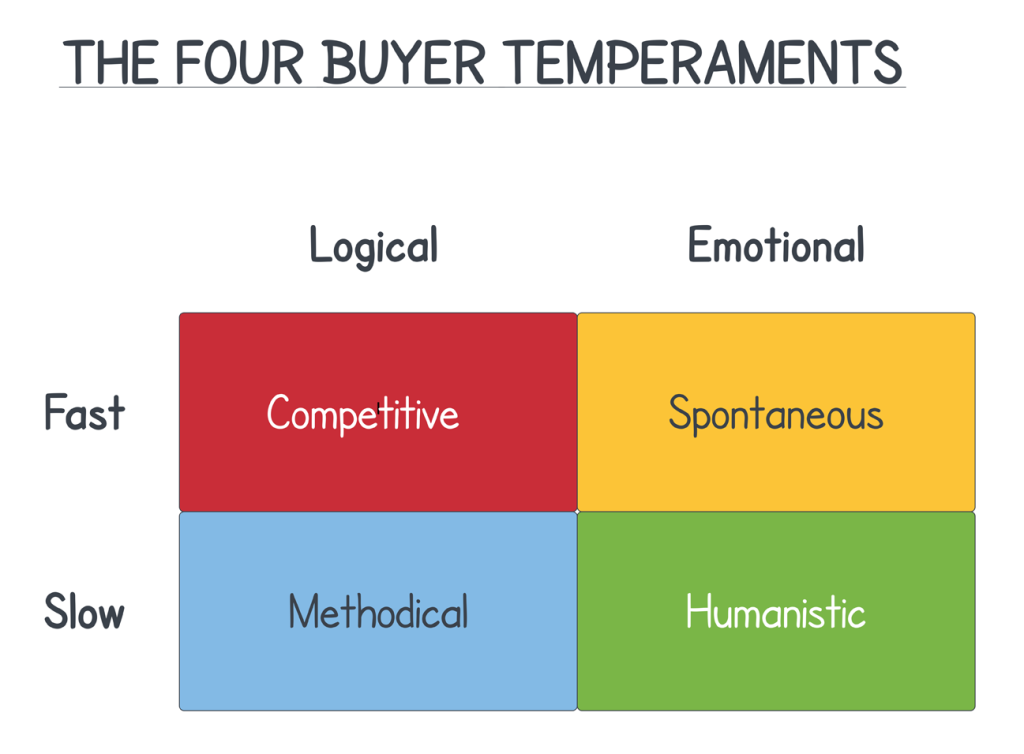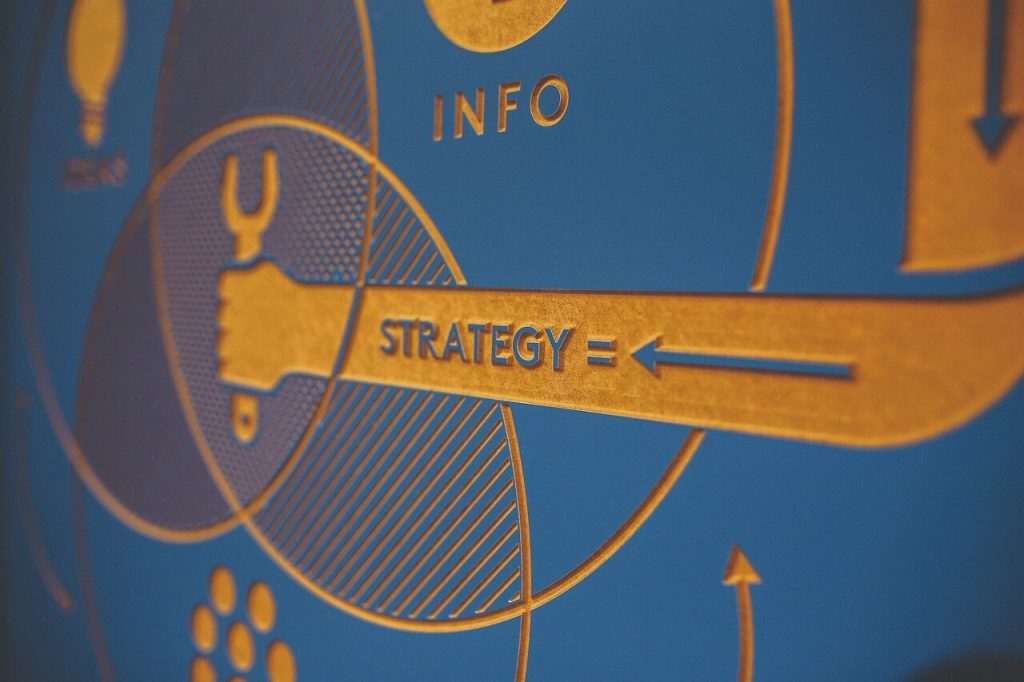UPDATED JUNE 17, 2024
Why get to know your buyer types?
In this post, we’re going to look at two sets of buyer types according to their personalities and temperaments.
Understanding what each of these buyer types is looking for will help you to create the right content for them. Content that will draw them to your site and give them what they need.
It might also be useful to understand these personalities if your product/service is particularly suited to a certain kind of buyer. Or, if you just prefer working with a certain type of buyer.
The four buyer personality types
There are four main buyer personalities:
- Assertive
- Amiable
- Expressive
- Analytical.
Each of these buyer personalities can be categorised according to how they make their buying decisions — whether that’s logically or emotionally and fast or slow.
The chart below illustrates where each buyer type fits in.


Now let’s have a look at each one in more detail so we can understand how best to create content for them.
1. How to write content for Assertive buyers
This is Alex. She’s a typical Assertive buyer, which means she’s ambitious, confident and driven by results.
She’s also impatient and likes to make her buying decisions quickly.


When writing for Assertive buyers, like Alex, you need to:
✅ Get straight to the point
✅ Make your information easy to consume
✅ Talk about the results you’ve achieved
✅ Use quantifiable numbers and facts.
And avoid:
❌ Long lead-ins or introductory stories
❌ Emotionally driven content
❌ Using subjective opinions/testimonials.
The best content for Assertive buyers is direct, results-focused and easy to digest, so try to:
✅ Give simple, effective explanations
✅ Make your content easily skimmable
✅ Use headings and short paragraphs
✅ Highlight key facts and numbers in call-outs
✅ Use numbered or bullet pointed lists
✅ Be visual with charts, graphs and infographics.
Show how your product/service will solve their problems and deliver results and give them a competitive edge.
2. How to write content for Amiable buyers
This is Michael. He’s a typical Amiable buyer, which means he’s friendly and sociable.
He values his relationships and prefers to do business with people he trusts and has a connection with.
Michael doesn’t like taking risks, so his buying decisions are slow, considered and may involve several other people from his team.


When writing for Amiable buyers, like Michael, you need to:
✅ Make a connection and gain their trust
✅ Satisfy the aims of various team members
✅ Use social proof and real-life examples
✅ Allay any concerns or reservations.
And avoid:
❌ Pushing for a sale too quickly
❌ Being too formal or impersonal
❌ Overloading them with information.
The ideal content for Amiable buyers is personal, empathetic and human, so try to:
✅ Have a friendly, conversational style
✅ Tell stories to help them imagine their results
✅ Use case studies and testimonials
✅ Guide them through their options
✅ Show expertise and give reassurance.
Show how your product/service will solve their problems and guarantee them a return.
3. How to write content for Expressive buyers
This is Anna. She’s a typical Expressive buyer, which means she’s creative, impulsive, confident and sure of herself.
Anna values long-term relationships and likes to feel she has your attention, respect and loyalty.
She’s driven by emotion and cares about the impact of her buying decisions on the people around her. But she’s also charismatic and will try to win others around to her way of thinking.


When writing for Expressive buyers, like Anna, you need to:
✅ Make a connection and build their trust
✅ Think in terms of an ongoing relationship
✅ Focus on the impact you make for humans
✅ Be open, honest and transparent.
And avoid:
❌ Focusing too much on facts and numbers
❌ Using unsubstantiated information
❌ Making off-hand claims or remarks.
The ideal content for Expressive buyers is personal, human and focused on longevity, so try to:
✅ Keep it informal and conversational
✅ Use case studies and client stories
✅ Anticipate their needs going forward
✅ Create ongoing content for customers.
Show how your product/service will solve the problem and benefit the people — both the people in the organisation and customers/clients of the organisation.
4. How to write content for Analytical buyers
This is David. He’s a typical Analytical buyer, which means he’s more thoughtful and less emotional in his purchasing decisions.
David likes to analyse data and compare products/services against each other. He takes his time and does his research before making a purchase and will want to have all the relevant information before he buys.
He’s less concerned with building relationships and likes to get straight down to business, so he prefers a more direct style with a focus on facts, figures and quantifiable information.


When writing for Analytical buyers, like David, you need to:
✅ Be direct and specific
✅ Understand what’s important to them
✅ Anticipate their questions
✅ Be detailed and thorough.
And avoid:
❌ Pushing for a sale/decision too quickly
❌ Making unsubstantiated claims.
❌ Leaving them with doubts or questions.
The ideal content for Analytical buyers is factual, data-driven and detailed, so try to:
✅ Answer their questions
✅ Include credible evidence
✅ Be upfront, honest and transparent
✅ Tackle their concerns and objections.
Show how your product/service performs and delivers results. Demonstrate how it compares to others in your own range — and in your industry as a whole.
The Eisenberg brothers’ four buyer temperaments
The Eisenberg brothers, who are experts in buyer personas, have identified four basic buyer temperaments.
They are:
- Competitive
- Spontaneous
- Methodical
- Humanistic.
Like the four buyer types in the first section, each of these buyer temperaments can be categorised according to how they make their buying decisions — whether that’s logically or emotionally and fast or slow.
There are both similarities and differences between those buyer types and these buyer temperaments.


1. How to write content for Competitive buyers
This is Ryan. He’s a typical Competitive buyer, which means he uses logic and facts to make quick buying decisions.
Ryan wants to feel he’s in control, he’s the best at what he’s doing and that he has a competitive edge over his rivals.


When writing for Competitive buyers, like Ryan, you need to:
✅ Lead with the most compelling benefits
✅ Support your claims with facts and figures
✅ Make data-driven, logical arguments
✅ Talk about results and achievements
✅ Make it quick and easy to consume.
And avoid:
❌ Long introductions
❌ Emotionally driven content
❌ Storytelling and scene setting.
The ideal content for Competitive buyers is logical, factual and quick to consume, so try to use:
✅ Quick, simple explanations
✅ Headings for skim reading
✅ Bullet points and summaries
✅ Visuals (charts, graphs, infographics).
Show how your product/service will solve their problem, put them in control, help them excel in their field and give them the competitive edge they’re looking for.
2. How to write content for Humanistic buyers
This is Millie. She’s a typical Humanistic buyer, which means she’s slow in her buying decisions and driven more by emotion than logic.
Millie values her communities and relationships and it’s important to her that she feels a personal connection with the person or brand she’s buying from.


When writing for Humanistic buyers, like Millie, you need to:
✅ Build your authority and gain their trust
✅ Show your personality and warmth
✅ Show you’re interested in helping them
✅ Talk about your brand, mission and values
✅ Think in terms of a longer relationship.
And avoid:
❌ Being too impersonal and factual
❌ Pushing for a sale too quickly
❌ Focusing on short-term goals.
The ideal content for Humanistic buyers is emotional, social and personality driven, so try to:
✅ Include photography
✅ Use storytelling and case studies
✅ Create a user or buyer community
✅ Encourage engagement and sharing
✅ Show your impact on the wider community.
Show how your product/service solved a problem for other customers and how it’s been received by other customers.
3. How to write content for Spontaneous buyers
This is Kadija. She’s a typical Spontaneous buyer, which means she likes things to be easy and convenient and makes quick buying decisions.
Kadija is emotionally driven and impulsive. She likes things to be simple and responds well to a more personalised approach.


When writing for Spontaneous buyers, like Kadija, you need to:
✅ Keep it simple and conversational
✅ Understand what’s important to them
✅ Help them make the right decision
✅ Make it easy for them.
And avoid:
❌ Overwhelming them with facts and figures
❌ Getting bogged down with too much detail
❌ Overcomplicating your content.
The ideal content for Spontaneous buyers is simple, convenient and easy to digest so try to use:
✅ Simple explanations
✅ Comparison charts and tables
✅ Bullet points and summaries
✅ Visuals and bitesize information.
Show how your product/service is the best one for them and how it will give them freedom and autonomy.
4. How to write content for Methodical buyers
This is Marcus. He’s a typical Methodical buyer, which means he’s slow, careful and deliberate in his buying decisions.
Marcus is guided by logic and facts. He likes to weigh up all the information and will expect to see proof and numbers before making his choice. In fact, he’ll probably consume all the information on your website before he ever reaches out to you.


When writing for Methodical buyers, like Marcus, you need to:
✅ Give them all the information they need
✅ Anticipate their questions
✅ Help them with their research
✅ Use credible sources and cite them.
And avoid:
❌ Pushing for a sale/decision too quickly
❌ Making assumptions about their needs
❌ Telling them what to think
❌ Making unsubstantiated claims.
The ideal content for Methodical buyers is logical, factual and objective, so try to to use:
✅ Long-form blog content
✅ White papers
✅ Comprehensive content hubs
✅ Detailed and in-depth research.
Show how your product/service will help them excel at what they do and be more effective than their rivals.
Need help with your blog content?
I’m Jenny Lucas, a freelance copywriter and content writer based in Leicester, UK.
I’ve been writing and optimising effective blog content that informs, educates and sells since 2008.
And I’m pretty damn good at it!
So if your blog has stalled or isn’t making you money, maybe I could help breathe some life into it and get it working hard for your business.
You can find more about me and my SEO content-writing services on my main website.


You might also like…






